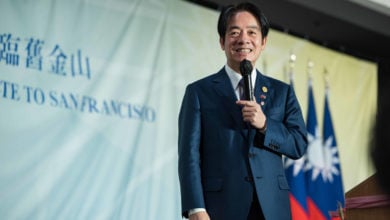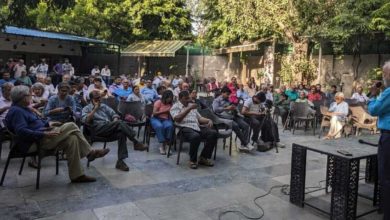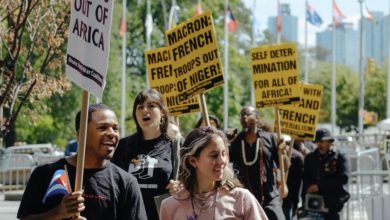Photo: A cobalt mining site in the DRC. Credit: Flickr/Fairphone (CC BY-NC 2.0 DEED)
Since 1996, at least six million people have been killed in successive conflicts in the eastern portion of the Democratic Republic of Congo. The same conflicts are largely responsible for the 6.9 million internally displaced people in the DRC today, one of the world’s largest populations of IDPs.1 Successive waves of violence have unfolded against a backdrop of a desperate struggle for the $24 trillion of mineral wealth embedded in Congolese soil.2 Despite immense wealth, nearly 60 million people — 64% of the country — live on less than $2.15 a day. One in six people living in extreme poverty in Sub-Saharan Africa are living in the DRC.3
The DRC produces the lion’s share of cobalt (70%) and coltan (60%), critical in powering our electronic devices.4 The country is the fourth largest producer of copper, which “sits at the heart of capturing, storing and transporting” electricity,5 as well the fourth largest producer of diamonds6 and has substantial reserves of gold, lithium, tungsten and manganese. It also ranks first in Africa in terms of hydropower potential, 100,000 MW, or 13% of the globe’s hydropower potential.7
Meanwhile, the DRC captures very little of the overall value of its products. In 2022, the country had a GDP of $64.7 billion, with at least $4.3 billion in illicit financial flows.8 The global tech industry made roughly $5 trillion in revenue in 2022.9 Apple, Alphabet and Samsung, just three of the scores of multi-nationals who couldn’t exist without the DRC’s minerals, made $156.7 billion in profit — more than double DRC’s official GDP.10 Despite the fact that without the Congo and its labor and resources, there would be no electric cars — with the average price of an EV in the United States in 2022 at $61,448 — miners in the DRC might make just below $3,000 a year. Some are working for far less, or caught in a form of modern slavery.11
The cradle of the DRC’s wealth is located in the eastern provinces: Ituri, North Kivu, South Kivu Taganyika. Here, over 120 armed groups — including the M23 rebel group (backed by Rwanda), the Allied Democratic Forces, and CODECO — have been waging offensives against the state, independent and government aligned armed groups, and different coalitions of East and Southern African nations.12
This regional struggle is primarily over who will be the interlocutors between the wealth of the DRC and the world. The international struggle over the African nation is similarly a question of who will set the terms of resource extraction. The DRC has become a battleground for local and regional elites to monopolize the lower rungs of global value chains, in addition to subjecting the country to the geopolitical implications of the search for profits by international mineral cartels and trillion-dollar electronic and information technology giants.
The DRC and the New Cold War
In the DRC, Chinese companies control 70% of the mining portfolio, while the rest are held by Western companies: Glencore, Barrick Gold, Ivanhoe Mines, along with Singaporean Trafigura.13 These companies mediate the process by which the raw materials become the finished goods — lithium ion batteries, gold bars, copper wires, heat capacitors for mobile phones, etc. — used by the Western consumer giants and a handful of Global South competitors.
The Chinese position in DRC has become a threat to the imperialist bloc as Rep. John James, chairman of the House Foreign Affairs Subcommittee on Africa, put it:
“Ensuring reliable and consistent U.S. access to critical mineral supply chains which originate in the DRC is integral to bolstering our national security.”14
As China has developed its own industries, U.S. anxiety over China’s dominant position in the mining sector has increased, raising the possibility of preferential access to strategic Chinese competitors in key sectors to critical minerals or parts made by them. China has been renegotiating mining deals and pledging greater sums for infrastructure, building on existing work building roads, hospitals and ports.15 The two nations have also begun negotiations on processing more minerals within the country.16 China has also provided military support for the DRC in the battle against M23.17 Further pressuring U.S. interests is the increasing presence of regional players like Turkey and Russia in various sectors of the Congolese economy.18
The United States has invested money into attempting to develop battery production supply chains in a joint effort with the DRC and Zambia.19 It is also funding, along with the EU, a $555 million railway from Angola into the heart of the DRC mining region,20 in addition to offering rare upbraids to close ally Rwanda for their role in supporting M23.21
Both sides are speaking to both a popular aspiration for the alleviation of poverty and an improved situation for DRC elites that are both linked to “security” in the East.
The politics of plunder
The top table of the political world is populated by the country’s richest men. One of the two major opposition leaders Moise Katumbi has a great fortune running into the tens of millions. The other, Martin Fayulu, was an executive for Exxon Mobil.22 The most recent former President Joseph Kabila has an extensive business portfolio, and current President Félix Tshisekedi has his own ties to DRC magnates.
DRC elites confront powerful undercurrents coming from below around security and economic issues. Eastern cities like Goma and Beni, for instance, have been the site of numerous protests, despite a “state of emergency” that functions as a form of martial law. Several large days of protest action saw tens of thousands take to the streets, linking war and the “balkanization” of eastern DRC by regional powers to the plunder of resources.23
Indeed, the countries most involved in various military interventions in the DRC are beneficiaries of its resource base. Of the gold produced in the DRC, 90% is smuggled through Rwanda and Uganda. At least 50% of Rwanda’s mineral exports — its second largest export earner — originated in the DRC, including 90% of coltan exports.24
The DRC is the third largest mover at Kenya’s Mombasa Port — more when you consider the mislabeled goods from Uganda, Rwanda and Burundi.25 Tanzania is embarking on “the most ambitious” rail project in Africa in order to capitalize on shipping out goods from the DRC.26
The second largest bank in the DRC is owned by Kenyan banking giant Equity Bank. Equity Bank’s top rival, KCB Group, owns another one of the DRC’s largest banks, and Tanzania’s largest retail bank formed a partnership with Scandinavian countries to buy into the market.27
Looking ahead
Despite the fierce contestation around the December 2023 elections in the DRC, the major candidates mainly presented a similar vision: ending armed conflict by waging offensives against the largest armed groups and incorporating the rest into state security structures, along with limited poverty alleviation through greater capture of resource revenues.
Given the similarities of rhetoric to the current administration, the immediate future likely looks similar. The current government has responded to popular pressure for greater development financed by the wealth generated by resource extraction. It has done so by moving to address some of the more glaring inequities of the various mining contracts that dominate the extraction scene gaining commitments to fund infrastructure and agreements that will see more tax revenue flow to the DRC government.28
The government has helped fund programs like Tshekedi’s 145 Territories Local Development Program (PDL-145T), which is a $1.6 billion fund spread over three years, building schools, health care facilities, local administrative buildings, roads etc.29 Large-scale agriculture is also emerging as a new industry.30
Undoubtedly these initiatives are important in some places, but the fact that the World Food Programme calls the DRC “the largest hunger emergency in the world,” and that unemployment currently stands at 80%, show how limited the various development initiatives are.31
Regional and international alliances will likely remain an unstable balance. Rwanda, Angola, Burundi and Uganda have the most direct military stake, with the latter three in stronger partnership with the DRC government. Rwanda, however, sees the DRC political class as a threat to their control of resource flows and supporter (including militarily) of its political opponents. This has prompted a permanent proxy strategy whose current incarnation is M23, making it likely that tensions will sharpen between Rwanda and DRC.
Globally, the Chinese “interest” is the most compatible with development initiatives of any significant scale. Breaking the high-tech monopoly and economic dependence on U.S. and EU markets are a precondition of reaching their goal of building a “moderately prosperous society” by 2050. This requires strong commercial relations with the DRC, and thus requires more receptivity to the terms that make the Congolese comfortable. Fully exploiting this trend will only emerge insofar as the ones doing the dealmaking represent the majority living in poverty.
Popular discontent propelled Dr. Denis Mukwege, a Nobel Peace Prize winner, into the presidential fray in a representation of the desire of many for a champion of the poor and displaced. An independent candidate with no party, his candidacy is representative of the movement of poor, working people and peasants as a whole, moving with energy, but still finding its organizational footing.
The future for the Democratic Republic of Congo is no doubt rocky in the near term, but the emergence of greater energy and organization in the fight against neocolonialism offers hope for the long term.
- https://www.iom.int/news/record-high-displacement-drc-nearly-7-million; https://www.fpri.org/article/2022/09/conflict-in-eastern-congo-a-spark-away-from-a-regional-conflagration/; https://www.unhcr.org/en-us/dr-congo-emergency.html ↩︎
- https://friendsofthecongo.org/congos-minerals/ ↩︎
- https://www.worldbank.org/en/country/drc/overview ↩︎
- https://www.investmentmonitor.ai/features/kinshasa-africa-democratic-republic-congo-cobalt/ ↩︎
- https://www.goldmansachs.com/insights/pages/gs-research/copper-is-the-new-oil/report.pdf ↩︎
- https://www.theglobaleconomy.com/rankings/diamond_production_carats/ ↩︎
- https://www.afdb.org/en/documents/democratic-republic-congo-inga-hydro-power-stations-and-kinshasa-distribution-network-rehabilitation-and-upgrade-rdpmdp-project-project-appraisal-report ↩︎
- https://www.imf.org/en/Publications/WEO/weo-database/2022/April/weo-report?c=614,638,616,748,618,624,622,626,628,632,636,634,662,642,643,734,644,646,648,652,656,654,664,666,668,674,676,678,684,688,728,692,694,714,716,722,718,724,199,733,738,742,746,754,698,&s=NGDPD,NGDPDPC,&sy=2022&ey=2022&ssm=0&scsm=1&scc=0&ssd=1&ssc=0&sic=0&sort=country&ds=.&br=1; https://www.brookings.edu/wp-content/uploads/2020/02/Illicit-financial-flows-in-Africa.pdf ↩︎
- https://www.bestcolleges.com/bootcamps/guides/largest-tech-companies-in-world/ ↩︎
- https://www.apple.com/newsroom/pdfs/FY22_Q4_Consolidated_Financial_Statements.pdf; https://www.sec.gov/Archives/edgar/data/1652044/000165204423000013/googexhibit991q42022.htm; https://www.gsmarena.com/samsung_reports_another_record_revenue_in_2022-news-57388.php ↩︎
- Siddharth Kara, Cobalt Red: How The Blood of The Congo Powers Our Lives (St. Martins, 2023) ↩︎
- https://kivusecurity.nyc3.digitaloceanspaces.com/reports/39/2021%20KST%20report%20EN.pdf; https://acleddata.com/conflict-watchlist-2023/drc/ ↩︎
- https://www.spglobal.com/commodityinsights/en/market-insights/latest-news/metals/120120-chinese-dominance-of-drc-mining-sector-increases-economic-dependence-mines-chamber ↩︎
- https://james.house.gov/media/press-releases/rep-james-introduces-bridge-drc-act ↩︎
- https://global.chinadaily.com.cn/a/202211/23/WS637d5377a31049175432b4e6.html; https://www.scmp.com/news/china/diplomacy/article/3222042/china-and-congo-agree-regular-checks-mining-deals; http://english.news.cn/20231004/aa380c1e9b024b4bb4e363be400539ee/c.html ↩︎
- https://actualite.cd/2023/06/06/rdc-le-nouveau-partenariat-de-cooperation-strategique-et-globale-avec-la-chine-va ↩︎
- https://peoplesdispatch.org/2023/12/20/as-the-drc-holds-another-election-the-fight-of-the-congolese-people-is-still-for-liberation/ ↩︎
- https://www.africanews.com/2023/10/19/drc-turkish-builders-faster-than-the-chinese/ ↩︎
- https://peoplesdispatch.org/2023/12/20/as-the-drc-holds-another-election-the-fight-of-the-congolese-people-is-still-for-liberation/ ↩︎
- https://www.africanews.com/2023/07/12/angola-and-drc-announce-joint-project-to-rehabilitate-railway-line//; https://www.railtech.com/infrastructure/2023/09/11/us-and-eu-jointly-support-new-african-railway-line-between-zambia-and-angola/?gdpr=accept; https://www.reuters.com/world/africa/trafigura-led-lobito-rail-upgrade-has-yet-find-users-2023-09-01/ ↩︎
- https://peoplesdispatch.org/2023/12/20/as-the-drc-holds-another-election-the-fight-of-the-congolese-people-is-still-for-liberation/ ↩︎
- https://www.forbes.com/sites/mfonobongnsehe/2018/07/31/dr-congo-multi-millionaire-moise-katumbi-seeks-to-return-home-to-contest-elections/?sh=333701d53a11; https://www.bbc.com/news/world-africa-35845556; https://www.theguardian.com/world/2017/jul/20/drc-vast-business-network-of-president-who-wont-step-down-revealed; https://www.reuters.com/world/powerful-business-lobby-replaces-ally-ex-congo-president-kabila-2020-12-23/ ↩︎
- https://x.com/eugenepuryear/status/1669343183388692487?s=46&t=gkcdVtxRtvHViIGNpZgyhQ; https://x.com/eugenepuryear/status/1599771474197639168?s=46&t=gkcdVtxRtvHViIGNpZgyhQ; https://x.com/eugenepuryear/status/1625612369299734528?s=46&t=gkcdVtxRtvHViIGNpZgyhQ ↩︎
- https://www.theglobeandmail.com/business/article-how-blood-mineral-traders-in-rwanda-are-helping-fund-congo-rebels-and/; https://www.theafricareport.com/265755/drc-finance-minister-kazadi-says-rwanda-gold-trade-holds-back-eac-potential/; https://www.newtimes.co.rw/article/4894/news/economy/rwandas-mineral-export-revenues-rise-by-52 ↩︎
- https://www.standardmedia.co.ke/financial-standard/article/2001454948/drc-now-third-largest-mover-of-cargo-at-mombasa-port ↩︎
- https://africa.businessinsider.com/local/markets/tanzanias-dollar22-billion-trade-route-to-drc-threatens-kenyas-trade-influence-in/q7jvwp8 ↩︎
- https://www.theeastafrican.co.ke/tea/business/east-africa-top-banks-scramble-for-a-piece-of-congo-market-3904950 ↩︎
- https://www.politico.cd/la-rdc-a-la-une/2023/02/21/contrat-sino-congolais-pressee-par-ligf-la-chine-accepte-de-verser-au-moins-500-millions-usd-pour-les-infrastructures.html/128780/ ↩︎
- https://www.politico.cd/la-rdc-a-la-une/2023/03/15/rdc-plus-de-760-millions-usd-deja-disponibilises-et-securises-pour-lexecution-du-programme-de-developpement-des-145-territoires.html/130047/amp/ ↩︎
- https://www.theeastafrican.co.ke/tea/business/kenya-drc-in-agricultural-cooperation-pact-3780588?view=htmlamp ↩︎
- https://peoplesdispatch.org/2023/12/20/as-the-drc-holds-another-election-the-fight-of-the-congolese-people-is-still-for-liberation/ ↩︎






